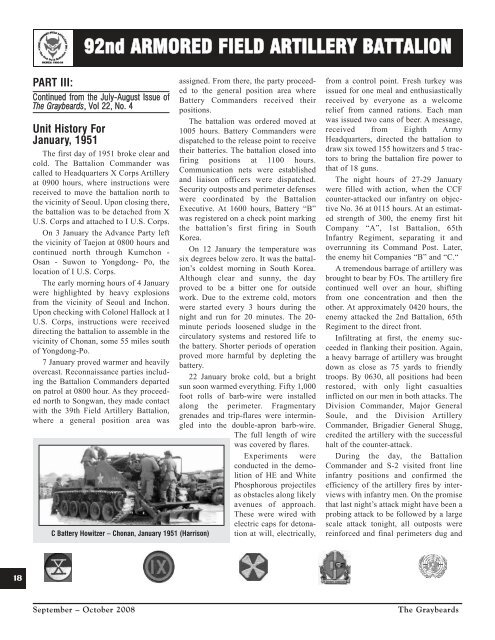Sep/Oct 2008 - Korean War Veterans Association
Sep/Oct 2008 - Korean War Veterans Association
Sep/Oct 2008 - Korean War Veterans Association
Create successful ePaper yourself
Turn your PDF publications into a flip-book with our unique Google optimized e-Paper software.
92nd ARMORED FIELD ARTILLERY BATTALION<br />
PART III:<br />
assigned. From there, the party proceeded<br />
to the general position area where<br />
Continued from the July-August Issue of Battery Commanders received their<br />
The Graybeards, Vol 22, No. 4<br />
positions.<br />
The battalion was ordered moved at<br />
Unit History For<br />
1005 hours. Battery Commanders were<br />
January, 1951<br />
dispatched to the release point to receive<br />
The first day of 1951 broke clear and<br />
their batteries. The battalion closed into<br />
cold. The Battalion Commander was<br />
firing positions at 1100 hours.<br />
called to Headquarters X Corps Artillery<br />
Communication nets were established<br />
at 0900 hours, where instructions were<br />
and liaison officers were dispatched.<br />
received to move the battalion north to<br />
Security outposts and perimeter defenses<br />
the vicinity of Seoul. Upon closing there,<br />
were coordinated by the Battalion<br />
the battalion was to be detached from X<br />
Executive. At 1600 hours, Battery “B”<br />
U.S. Corps and attached to I U.S. Corps.<br />
was registered on a check point marking<br />
the battalion’s first firing in South<br />
On 3 January the Advance Party left<br />
Korea.<br />
the vicinity of Taejon at 0800 hours and<br />
continued north through Kumchon -<br />
On 12 January the temperature was<br />
Osan - Suwon to Yongdong- Po, the<br />
six degrees below zero. It was the battalion’s<br />
coldest morning in South Korea.<br />
location of I U.S. Corps.<br />
Although clear and sunny, the day<br />
The early morning hours of 4 January<br />
proved to be a bitter one for outside<br />
were highlighted by heavy explosions<br />
work. Due to the extreme cold, motors<br />
from the vicinity of Seoul and Inchon.<br />
were started every 3 hours during the<br />
Upon checking with Colonel Hallock at I<br />
night and run for 20 minutes. The 20-<br />
U.S. Corps, instructions were received<br />
minute periods loosened sludge in the<br />
directing the battalion to assemble in the<br />
circulatory systems and restored life to<br />
vicinity of Chonan, some 55 miles south<br />
the battery. Shorter periods of operation<br />
of Yongdong-Po.<br />
proved more harmful by depleting the<br />
7 January proved warmer and heavily battery.<br />
overcast. Reconnaissance parties including<br />
the Battalion Commanders departed<br />
22 January broke cold, but a bright<br />
sun soon warmed everything. Fifty 1,000<br />
on patrol at 0800 hour. As they proceeded<br />
north to Songwan, they made contact<br />
foot rolls of barb-wire were installed<br />
along the perimeter. Fragmentary<br />
with the 39th Field Artillery Battalion,<br />
grenades and trip-flares were intermingled<br />
into the double-apron barb-wire.<br />
where a general position area was<br />
The full length of wire<br />
was covered by flares.<br />
Experiments were<br />
conducted in the demolition<br />
of HE and White<br />
Phosphorous projectiles<br />
as obstacles along likely<br />
avenues of approach.<br />
These were wired with<br />
electric caps for detonation<br />
at will, C Battery Howitzer – Chonan, January 1951 (Harrison)<br />
electrically,<br />
from a control point. Fresh turkey was<br />
issued for one meal and enthusiastically<br />
received by everyone as a welcome<br />
relief from canned rations. Each man<br />
was issued two cans of beer. A message,<br />
received from Eighth Army<br />
Headquarters, directed the battalion to<br />
draw six towed 155 howitzers and 5 tractors<br />
to bring the battalion fire power to<br />
that of 18 guns.<br />
The night hours of 27-29 January<br />
were filled with action, when the CCF<br />
counter-attacked our infantry on objective<br />
No. 36 at 0115 hours. At an estimated<br />
strength of 300, the enemy first hit<br />
Company “A”, 1st Battalion, 65th<br />
Infantry Regiment, separating it and<br />
overrunning its Command Post. Later,<br />
the enemy hit Companies “B” and “C.“<br />
A tremendous barrage of artillery was<br />
brought to bear by FOs. The artillery fire<br />
continued well over an hour, shifting<br />
from one concentration and then the<br />
other. At approximately 0420 hours, the<br />
enemy attacked the 2nd Battalion, 65th<br />
Regiment to the direct front.<br />
Infiltrating at first, the enemy succeeded<br />
in flanking their position. Again,<br />
a heavy barrage of artillery was brought<br />
down as close as 75 yards to friendly<br />
troops. By 0630, all positions had been<br />
restored, with only light casualties<br />
inflicted on our men in both attacks. The<br />
Division Commander, Major General<br />
Soule, and the Division Artillery<br />
Commander, Brigadier General Shugg,<br />
credited the artillery with the successful<br />
halt of the counter-attack.<br />
During the day, the Battalion<br />
Commander and S-2 visited front line<br />
infantry positions and confirmed the<br />
efficiency of the artillery fires by interviews<br />
with infantry men. On the promise<br />
that last night’s attack might have been a<br />
probing attack to be followed by a large<br />
scale attack tonight, all outposts were<br />
reinforced and final perimeters dug and<br />
18<br />
<strong>Sep</strong>tember – <strong>Oct</strong>ober <strong>2008</strong><br />
The Graybeards

















